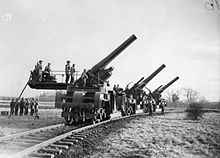305mm Mk V Railway Howitzer
The 305mm Mk V Railway Howitzer was a British railway gun from the First World War .
history
During World War II all the powers involved sought ways deadlocked trench warfare with ever larger artillery calibers to decide for themselves. Almost everywhere, the only way to move such ever larger guns was to accommodate the gun carriage on large railroad cars. In some countries, for example in imperial Germany , guns such as the Fat Bertha were also built with wheel-mounted guns.
The British company Vickers presented the Mk I railroad howitzer. However, the British Army Office rejected the weapon because of insufficient mobility and range. Further developments led to the Mk V. This gun was eventually used in France.
In 1939 some Mk Vs were still in service with the British Army to ward off a possible invasion of the German Wehrmacht on the Channel coast.
technology
Unlike other railway guns, the Mk V had a lateral directional range of 240 °. Therefore it was not necessary to set up a complex track system. However, the elevation range for a howitzer was somewhat limited. Only + 20 ° should be reached, otherwise there was a risk that the carriage would jump out of the track bed, although the maximum range was 0 ° to + 45 °.
The carriage consisted of two carrier cars with two axles each. These carried the actual carriage structure. For firing, booms were extended, which should give the structure additional stability.
Technical specifications
- Caliber: 305 mm
- Pipe length: 5.71 m
- Total length: 12.20 m
- Combat weight: 77,170 kg
- Elevation range: 0 ° to + 45 °
- Side straightening range: 240 °
- Ammunition type / ammunition weight: fragmentation explosive projectile, 340 kg
- Muzzle velocity: 448 m / sec
- Maximum shooting range: 13,120 m
Web links
literature
- Ian Hogg : 20th Century Artillery . Gondrom Verlag, Bindlach 2001, ISBN 3-8112-1878-6 .

